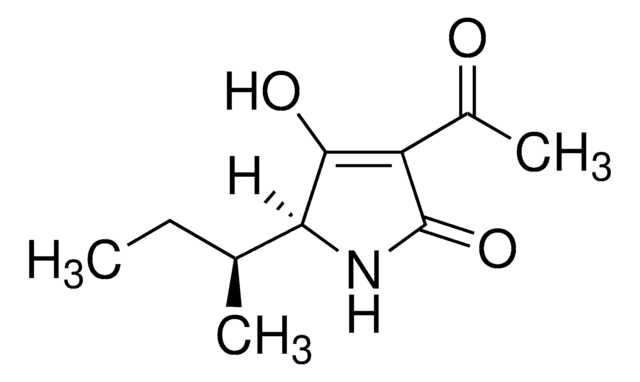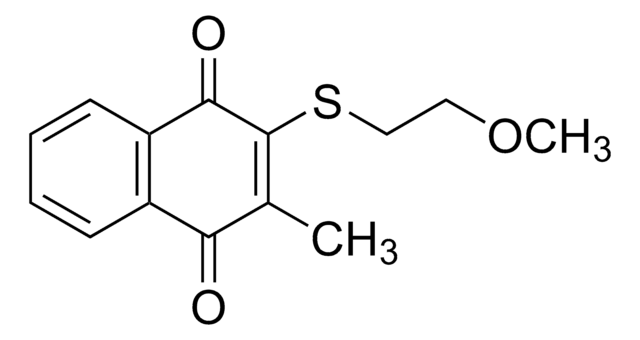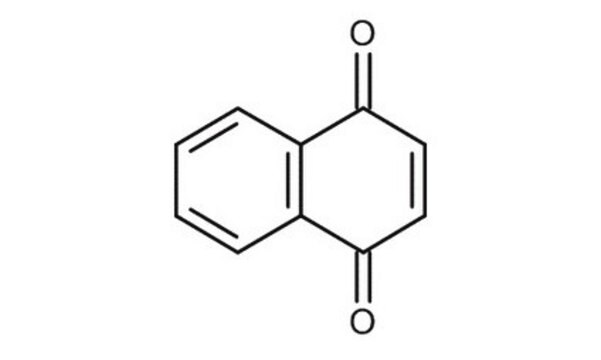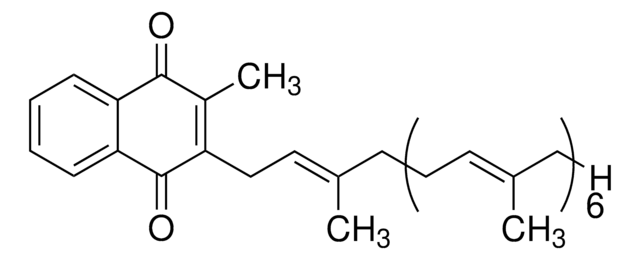Kluczowe dokumenty
47775
Menadione (K3)
analytical standard
Synonim(y):
Menadione, 2-Methyl-1,4-naphthoquinone, Vitamin K3
About This Item
Polecane produkty
klasa czystości
analytical standard
Poziom jakości
Certyfikat analizy
current certificate can be downloaded
Właściwości
standard type fat soluble vitamin
opakowanie
ampule of 1000 mg
metody
HPLC: suitable
gas chromatography (GC): suitable
mp
105-107 °C (lit.)
Zastosowanie
pharmaceutical (small molecule)
vitamins, nutraceuticals, and natural products
Format
neat
temp. przechowywania
2-30°C
ciąg SMILES
CC1=CC(=O)c2ccccc2C1=O
InChI
1S/C11H8O2/c1-7-6-10(12)8-4-2-3-5-9(8)11(7)13/h2-6H,1H3
Klucz InChI
MJVAVZPDRWSRRC-UHFFFAOYSA-N
informacje o genach
human ... NQO1(1728)
Szukasz podobnych produktów? Odwiedź Przewodnik dotyczący porównywania produktów
Powiązane kategorie
Opis ogólny
Zastosowanie
Hasło ostrzegawcze
Warning
Zwroty wskazujące rodzaj zagrożenia
Zwroty wskazujące środki ostrożności
Klasyfikacja zagrożeń
Acute Tox. 4 Oral - Aquatic Acute 1 - Aquatic Chronic 1 - Eye Irrit. 2 - Skin Irrit. 2 - Skin Sens. 1 - STOT SE 3
Organy docelowe
Respiratory system
Kod klasy składowania
11 - Combustible Solids
Klasa zagrożenia wodnego (WGK)
WGK 3
Temperatura zapłonu (°F)
Not applicable
Temperatura zapłonu (°C)
Not applicable
Środki ochrony indywidualnej
dust mask type N95 (US), Eyeshields, Faceshields, Gloves
Wybierz jedną z najnowszych wersji:
Masz już ten produkt?
Dokumenty związane z niedawno zakupionymi produktami zostały zamieszczone w Bibliotece dokumentów.
Klienci oglądali również te produkty
Protokoły
Separation of (±)-α-Tocopherol, analytical standard; Menadione (K3), analytical standard; (+)-γ-Tocopherol, analytical standard; Cholecalciferol (D3), analytical standard
Nasz zespół naukowców ma doświadczenie we wszystkich obszarach badań, w tym w naukach przyrodniczych, materiałoznawstwie, syntezie chemicznej, chromatografii, analityce i wielu innych dziedzinach.
Skontaktuj się z zespołem ds. pomocy technicznej













